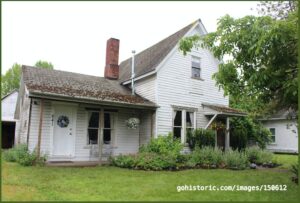En el gran final de la segunda temporada, les presentamos a una madre y una hija que llegaron a Oregón en 1844. Eran esclavas al comienzo de su viaje a lo largo de la Ruta de Oregón, liberadas mientras vivían y trabajaban en Oregón.
Aquí es donde nosotros, Querido Intrépido Explorador, comenzamos nuestro viaje en esta temporada de Spectres Past, con la madre Hannah y la hija Eliza, dos de las residentes trabajadoras y con espíritu comunitario del condado de Benton.
TU MISIÓN

Explore la historia de estos antiguos esclavos: un dúo de madre e hija que, frente a enormes dificultades, se convirtieron en propietarios de tierras y negocios de servicios amados por su comunidad en Corvallis, Oregón.
SUS OBJETIVOS
Resuelva los desafíos comenzando haciendo clic en el AVENTURA EN LÍNEA para desentrañar la historia y descubrir lo que realmente estaba sucediendo en ese fatídico día.
HERRAMIENTAS Y PIEZAS DE JUEGO
Haga clic en el AVENTURA EN LÍNEA en la esquina superior derecha para comenzar.
O, si tiene la intención de hacer esta aventura EN LA TIERRA, descargue la versión PDF para obtener la versión en papel tradicional.
¡Alerta de spoiler! Las SUGERENCIAS en las pestañas de arriba pueden contener información pertinente al desafío en curso que le permitirá completar los desafíos si está estancado o bloqueado.
La mayoría de los desafíos tienen un tiempo límite de 30 segundos que puedes usar para saltarlo. Simplemente intenta resolver el rompecabezas durante 30 segundos y aparecerá un botón "Omitir" debajo de los rompecabezas.
Nota: No es que 30 segundos sea el tiempo que debería tomar, ni mucho menos; la mayoría tardará mucho más. Sin embargo, si un jugador ya resolvió el rompecabezas o simplemente está navegando o saltando, 30 segundos es solo el tiempo que tarda en aparecer.
Los recursos históricos que inspiraron los desafíos del episodio uno

Plano de la casa Gorman
Se cree que esta propiedad histórica en Corvallis, condado de Benton, Oregón, es una de las casas más antiguas que se sabe que perteneció a afroamericanos (esclavos liberados) en Oregón. La casa estaba programada para ser demolida, pero Patricia Benner y su socio Tony Howell la salvaron de la demolición en 2004.
Patricia y Tony encuentran inspiradora la historia de las propietarias, madre e hija, Hannah y Eliza Gorman, tanto que Patricia escribe sobre ellas y la casa que compartían en Corvallis, Oregón.
Patricia escribe en el prólogo de su próximo libro: Hannah y Eliza Gorman: madre e hija, pioneras negras de Oregón: extractos de su historia “A medida que fui conociendo a Hannah y Eliza Gorman a través de los pequeños restos de información que quedaban sobre ellas, me sentí inspirada y admirada por estas dos mujeres. Ser negras, mujeres y haber nacido esclavas, en una época con sus difíciles desafíos… no solo prosperar, sino contribuir…”

Tcha Timanwi (también conocido como Pico de María)
fotografía © Mark van der Pol
Marys Peak, a 4.097 pies, es el punto más alto de la Cordillera Costera de Oregón y el pico más destacado al oeste de Corvallis.
Según la Sociedad Histórica del Condado de Benton, los nativos Kalapuya llamaban al pico tcha Timanwi, o "lugar de poder espiritual".
El 15 de junio de 2019, la Junta de Nombres Geográficos de Oregón aprobó por unanimidad una propuesta para dar nombres nativos americanos a diez arroyos sin nombre que descienden por el Pico de Mary. Las Tribus Confederadas de Grand Ronde y las Tribus Confederadas de Siletz participaron en la representación de los antiguos grupos indígenas y en la selección de los nuevos nombres. Los nombres propuestos para su adopción provienen de las lenguas de los pueblos kalapuya, wusi'n y yaqo'n, que habitaron originalmente la tierra. La aprobación de la junta nacional podría tardar hasta un año.1
Estamos agradecidos a...

